 Leading Blog | Posts by Category |
 Leading Blog | Posts by Category |
12.15.23

Visionary Thinking Is a Practiced Skill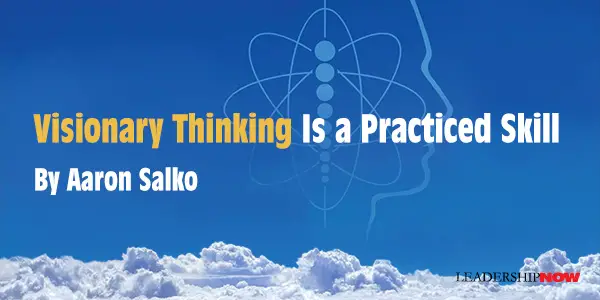
VISIONARY THINKING is the ability to see the big picture, envision what the future could look like, build a plan to achieve that vision, and lead yourself and others down the path of execution. First, you see things in your mind, and then you work both consciously and subconsciously to make them happen. In my younger years, I had many visions of the ideas, goals, and positions that I wanted to achieve. Some of them came to fruition. Some took me down other roads that led me to new experiences, which brought with them new visions. All were worth the effort and journey, and I realized very early on that visionary thinking was a major contributor to the success levels I had attained. As I looked back, I realized that most, if not all, of the 45 Performance-based Skills are utilized in some way during visionary thinking. It’s important to explain our society’s view of visionaries in order to shift your mindset away from thinking it’s unattainable. Having visions and being able to execute them will have an impact on the success levels you’ll achieve. Those who lack vision or don’t know how to identify and act on their vision will struggle with wealth attainment, achievement of goals, and personal fulfillment. When most of us think of visionary thinkers, names such as Thomas Edison, Albert Einstein, Steve Jobs, Elon Musk, Sheryl Sandberg, and Jeff Bezos come to mind. They’re viewed by many of us as “magical creatures.” That sets a high bar for the practice of visionary thinking. I’m not trying to downplay the incredible success these people have achieved, but I believe everyone is capable of being a visionary — you just need to develop the skills to identify the vision and then bring it to reality. Who knows, maybe one of your visions could be the next Amazon.com. A powerful vision creates the will to make change happen and harnesses the energy that will be needed. It inspires action and recruits the people and resources needed for new perspectives and ideas. It motivates individuals and organizations to commit to achieving the overall goal — no matter the number of roadblocks that get in the way. Here are the components that form the backbone of visionary thinking: 1. Cultivate a visionary mindset: To create a vision that elicits excitement and interest, you must give yourself the freedom to dream. Imagination is the key that unlocks the door to seeing and feeling what doesn’t yet exist. You must be bold in your thinking. To do that, you must allow yourself to think in the abstract. This entails battling against your own and our society’s programmed channels of thought. Then, integrate the abstract rationally into the real world in order to map the pathway to execution. 2. Tap into your subconscious: Your subconscious is the key to creating a pathway that makes a vision a reality. It’s important to get in tune with your intuition or gut instincts. Gut instincts are actually your subconscious directing your actions based on all the information it gathered while you were busy in your conscious life. In visionary thinking, you use your subconscious as a guidance tool. It will direct you as you navigate decisions, direction, and key components needed to create your vision. 3. Unleash your creativity: Have you ever been asked to “think outside the box”? If you are methodical and analytical, that statement probably makes you cringe. If you are artistic and creative, that statement most likely gets you excited. The reality is that creativity in your career environment is derived from both the need to solve a problem and the desire to avoid or solve future problems (which often leads to innovation). So, if you feel that you’re not a creative person, I will challenge you with the fact that you actually are because you’ve most likely had to create a solution to fix a problem at some point. This is the essence of creativity, although it goes well beyond problem-solving. It’s rooted in the deep desire to do things that go against the norm and push ideas that others may say are impossible. To be a wildly successful visionary, you must not fear creativity. 4. Hone your social skills: Having a vision is great, but unless you can help others see it and get them behind the execution, it will most likely die on the vine. This is why social interaction skills and boldness are so important to visionaries. They never do it alone. Visionaries get others involved and use the talents that surround them. Communication, trustworthiness, empowerment, networking, and likability are just some of the performance-based skills that you’ll need to optimize in order to influence others in the execution of your vision. 5. Embrace discomfort: When your mind is telling you that it has nothing to go on and lacks the ability to guide your path, embrace it! Nervousness is just your body preparing for action, and with the correct mindset, it can be a positive part of the process. Simply accept that you’re in an area of discomfort and that what happens next will bring with it experience, which in turn will raise your knowledge and confidence. When you embrace your discomfort and acknowledge your inexperience, the pressure reduces and the mind shifts. The best part of visionary thinking is that everyone is capable of it. The hardest part is taking the first step.  
Posted by Michael McKinney at 12:31 PM
01.28.22

Provoke Your Future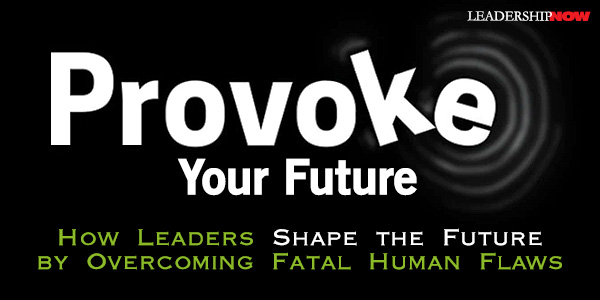
WHEN faced with uncertainty, the intuitive response is to “wait-and-see.” We get stuck in the momentum of the past and the need for solid ground, making it harder for us to capitalize on emerging trends and changes. More often, we miss them entirely and scramble to respond if we can. In Provoke, authors Steven Goldbach and Geoff Tuff explain that there are two phases to any trend: If and When. And between the two is a transition they call the Phase Change. In the initial “if” stage, it’s still uncertain if the trend will come to fruition; in the “when” stage, the trend has progressed, gathered momentum, and crossed an important inflection point where it’s no longer uncertain whether it will come to fruition. It’s only a question of when and, sometimes, to what extent.
The challenge is to get ahead of the Phase Change so that you can make the most of the emerging opportunity. The wait-and-see approach doesn’t work. You must act and provoke a better future. These days, the conviction to act—especially in the absence of perfect data—is the only way to provoke the future you desire. Action creates energy. Action allows you to position yourself to see the peak sooner and more clearly than others. Action gives you the power to move through the phase change of “if” to “when” so that you can make the most use of the kinetic energy when it is released. But how do you spot trends? And what trends? In the beginning, the signals are weak and hard to see. We easily miss them. “The best provocateurs pay attention to all weak signals, at least to begin with. As a general rule of thumb, anything that has the possibility of impacting your foundational business model—or mission—should be paid particular attention to.” To do this well, you need a model of provocation to access early and weak signals as they appear on your radar. The authors present five principles of provocation: 1. Envision the Future This is an ongoing provocation. “The most powerful envision moves involve the development of multiple scenarios or stories of how the future could unfold, along with leading indicators that help give notice when the relative likelihood of any given scenario goes up or down.”2. Position Yourself for Success While a trend is still in the “if” phase, you want to position yourself to better understand and explore the trend as it starts to reveal itself. A tend moves into the “when” phase primarily in one of two ways: naturally (no primary cause) and synthetically (happens because of action you, and usually, others take). 3. Drive Change The Drive provocation is used when the future can be driven by the organization’s own actions. “These are the provocations that allow you to act in a way that creates advantage in a world that you know is going to come true ... even if you don’t know exactly when.” 4. Adapt “In adapt, while you are still able to shape your own destiny, you believe you can’t have influence on the trend itself in a way that is perfectly consistent with your existing business model; you just need to reshape your organization to take advantage of the trend.” 5. Activate Your Ecosystem It is rare that your organization has the skills and resources required to shape the future alone. We have to look beyond our organization. “The trick for executives these days is to consider the ecosystem options in front of them in a way that allows them to make a choice that leads to advantage from participation in the direction that they have decided to provoke.” The purpose of a provoke mindset is to enable a series of minimally viable moves that continuously shape the trend as it unfolds. It’s likely that the path to provoking a better future is a smooth arc. Rather, it’s likely to require multiple small recalibrations along the way. The best strategy is a continuous learning process of aiming-acting-learning against the trend, understanding the nature of the impact you are able to have on a given trend, and leveraging minimally viable moves to make forward progress. In times like these, action beats wait-and-see. The ability to act, adapt, and act again provides an advantage in times of great change. Provoke the future. 
Posted by Michael McKinney at 02:37 PM
04.02.21

Lead from the Future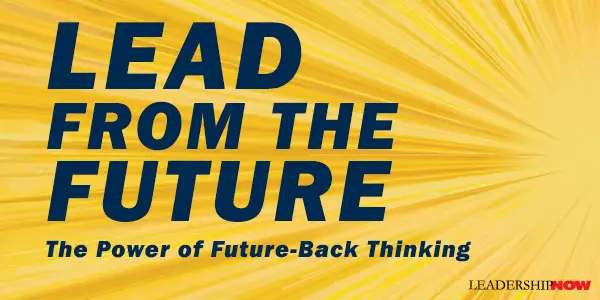
THERE is present-forward vision, and there is future-back vision. There is a difference. Present-forward thinking will get you incremental change and often leaves you stuck in the present. Future-back thinking expands your horizon to see opportunities that are beyond your core business. Future-back helps you quiet the noise today to see the faint signals that could disrupt your business or activities tomorrow. In Lead from the Future, Mark Johnson and Josh Suskewicz describe future-back thinking as “a way of seeing and being in the world.”  While we need to master the present, we can be lulled into thinking that the future will take care of itself because we are making our quarterly numbers. Most founders are future-back thinkers, but “most incumbent organizations are led by people who are much less future-thinking than their founders.” And understandably so, we must succeed in the present. But if we are to survive into the future, we need to be capable of mastering the future too and turn that vision into action today. Present-forward thinking is high in knowledge and driven by known rules, facts, and data; future-back thinking is low in initial knowledge and high in assumptions—its aim is to discover what could be true. The authors offer a three-step process to help leaders develop visionary strategies and bring them to life. 1. Develop Your Vision Identify the potential inflection points in your industry and focus on the timeframe when they are likely to occur. 2. Convert Vision to Strategy To connect your vision of the future to a concrete plan for what you must do today to bring it to life, you need to develop three portfolios: future state portfolio, innovation portfolio, and an investment portfolio. These are “continually updated and tracked as you reshape your vision based on the new learning that comes over time.” The future state portfolio helps you identify your growth gap – what you will need to provide beyond what you are capable of delivering presently to reach your vision. These needed capabilities become your innovation portfolio. Develop an investment portfolio in which you formalize your decisions about where to invest and where your resources will come from. In building it, you should measure dollars but also people and leadership mindshare, as talent and leadership energy are often more scarce in big companies than seed funding. 3. Program & Implement the Strategy Just as a vision needs to be translated into a strategy, a strategy must be carefully programmed into an organization before it can be effectively implemented. The leadership framework shown below highlights the mindsets for both present-forward and future-back leadership. It is not an either/or proposition. The most successful leaders will be those who can do both as needed. A leader described the left side as “serious, disciplined, and self-critical” and the right side as “aspiration, optimism, and risk orientation.”
In The Innovator’s DNA, Clay Christensen identified five attributes that correlate closely with Future-Back Leadership: associating, questioning, observing, experimenting, and networking. Business innovators are sponges for unfamiliar ideas; as such they seek out conferences and other venues to exchange and combine their ideas. Once you understand the principles presented here, you can begin to look at everything with a future-back mindset—including your own life. We need as leaders to have and immerse our teams and organizations with a learning mindset. The tyranny of the present quickly pulls us back into a short-term present-focused mindset. We need to look for the balance and link the present with the future. Future-back needs to become an organizational capability, led at the top, and permanently embedded in leadership mindsets, strategic planning processes, and organizational culture. 
Posted by Michael McKinney at 07:05 AM
12.15.20

Uncharted: How to Navigate the Future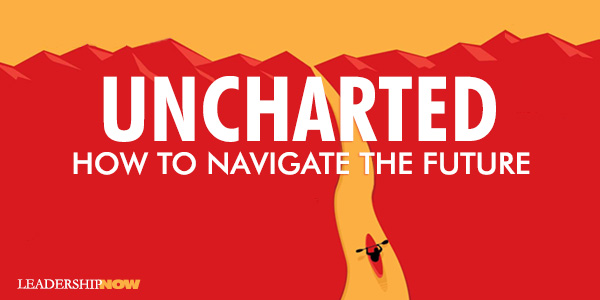
PREDICTION has never been easy – or that accurate. Over and over again, forecasts and models fail us. And when they do, they won’t go away because the agenda behind them lives on. As a model or a forecast is designed to do, we become “recruited into an army of believers.” “The more we believe, the less we question,” says Margaret Heffernan. In Uncharted: How to Navigate the Future, she writes that “Overwhelmed with complexity, we seek simplification and too quickly reach for binary perspectives, just at the moment when we need broader ones.” How true. We crave certainty in a world that remains ambiguous. In an outstanding first chapter—False Profits—she reviews the work of three economic forecasters and the shortcomings and consequences of each. Forecasts and models are useful if they get you thinking, but only if we see them for what they are—propaganda.
Our past informs our present and future, but it can’t predict it. History, especially our personal history, defines a trajectory and provides us with probabilities. It tells us how we tend to react to what life throws at us, but we also have the capacity to learn and grow and change. New experiences shape us.
Believing that his history always repeats itself can lead to “blindness and blunder.”
Much of what she is talking about here defines the year 2020. So, if we can’t predict the future, what can we do? First, we can experiment more. In a time of crisis, we need to know more. We need to experiment. Experiments are an “antidote to helplessness or passivity. They set us on paths that reveal new knowledge and choices.” We can develop scenarios to “identify and test how and where the future and the present meet.” Different from experiments that “reveal immediate internal features of a complex system, scenarios explore where the internal organization meets the external environment, where uncertainties lurk beyond anyone’s control.” Scenario planning always surfaces conflict and there is always a moment when everything seems to fall apart. But getting the conflict out in the open, constructively, is crucial; it’s how and when people start to acknowledge and consider alternative perspectives. Third, we need to think like an artist. Artists think for themselves. They pay attention. Notice more. And then they let it sit—simmer, filter, distill, digest. Then they act. The only way to know if you are on to something is to start. I liked the phrase: “moving in and out of focus, trying to get a feel for something that doesn’t exist yet.” To have insights that are relevant to life requires having a life, one rich in experiences, and the time to internalize them. Fourth, think beyond. Start a Cathedral Project. Cathedral projects are unpredictable from the beginning. “They are destined to last longer than a human lifetime, to adapt to changing tastes and technologies, to endure long into the future as symbols of faith and human imagination.” They are also full of experiments making them “intrinsically, ambiguous, uncertain, and full of risk.” They attract brilliant minds because “the scale of their aspiration ensures that, instead of being passive victims of the future, they are actively involved in making it.” Imagination, creativity, compassion, generosity, variety, meaning, faith, and courage: what makes the world unpredictable are the same strengths that make each of us unique and human. Accepting uncertainty means embracing these as robust talents to be used, not flaws to be eliminated. 
Posted by Michael McKinney at 05:11 PM
09.26.19

How Your Bright Shiny Objects Derail Your Team — and Damage the Business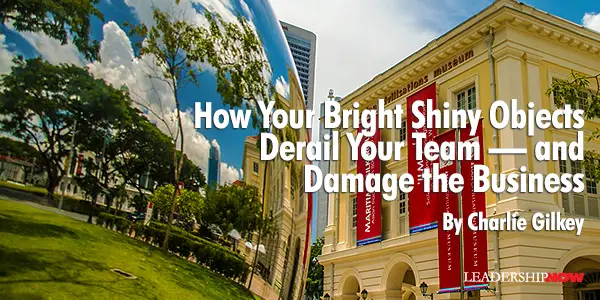
IN COACHING VISIONARY LEADERS, I hear a common pain point: Their team isn’t moving fast enough or focusing on the right things. As we dig deeper, however, we inevitably discover that their team isn’t the problem. Instead, it’s their own preoccupation with bright shiny objects — or what I call BSOs. From madcap product ideas to mythic mergers, BSOs can run the gamut. All the same, they’re a challenge for visionary leaders. No doubt, their ability to bridge the gap between unlimited possibility and reality is a critical skill. But, when left unchecked, their attraction to BSOs often hurts their teams, usually by derailing their work with needless obstacles. Even more critically, BSOs have the propensity to damage the business. How? By introducing ideas that should have never been considered in the first place. After all, just because something could be done doesn’t mean it should be done. If you’re a visionary leader, and can admit to loving BSOs, you most likely need a process to better understand, manage, and vet them. Ask yourself questions Imagine a typical Monday morning huddle. Your team is busy discussing current or upcoming projects and priorities. Then, with unbridled exuberance, you storm in and say, “I’ve got an amazing idea.” Unbeknownst to you, it’s like you just lobbed a bomb onto the team. Now, to indulge your BSO, they lose their energy and focus. So how can you tell when you’ve just lobbed a BSO onto your team? Stunned silence. Rolling eyes. Icy stares. Crossed arms. A barrage of questions. Those are only some of the signs. Plus, under their breath, people are probably muttering some kind of rebuke. “Are you kidding me?” “Oh, come on. Seriously?” “Here we go again.” “But what about…?” Et cetera. To avoid such an experience — let alone not derail your team — make a habit of first asking yourself a few questions about your current BSO. Consider these five to start: 1. How does this align with the business’s current strategies and priorities? 2. How would doing this affect other, more important work? 3. What business concerns would this solve, and do we already have other, potentially better solutions in place? 4. If this is actually something we should do, what is the best timing — to do it now or to wait until some other business priorities have been met? 5. Who can I run this by before lobbing it onto my team? Enlist a “voice of no” At some point, most visionary leaders learn that they need a COO or other common-sense leader to counterbalance their BSOs. I call such a person a “voice of no.” So, when a visionary leader brings up a BSO, her voice of no might say, “Here’s why we can’t do that right now” or “Here’s what must happen first.” In this way, a voice of no protects a leader’s team from creative mayhem while also not stifling the leader’s visionary proclivities. In considering a COO or a voice of no, look for someone who clearly gets the importance of focus, continuity, and business priorities, and who seems to have a “less is more” mindset — preferring to do fewer things very well than to do many things ineffectively. If you’re not in a position to bring in a COO or a voice of no, you can develop your team to take on the role. This, however, will require you to openly acknowledge your BSO inclinations, to have clear-cut business imperatives, to give people the authority and freedom to ‘gut check’ your ideas, and to make room in meetings for real, strategic conversations. Have a vetting process It took me years to recognize my own insatiable appetite for BSOs. The good news is I now have a simple process in place to properly vet my BSOs and, in doing so, to protect my team from any “incoming.” To start vetting your own BSOs, I suggest these four steps: 1. Find a sounding board. Seek out someone thoughtful and measured, inside or outside the business but not on your team, to serve as your sounding board. Look for someone who you can trust and feel comfortable with to casually bounce around ideas and, equally important, who is fully capable of being candid with you. For me, that’s my business partner and wife, Angela, who also acts as my voice of no. If she isn’t convinced, I know to let go of a BSO or at least put it on ice. 2. Put your idea in writing. If your idea seems workable after bouncing it off your sounding board, put it in writing. This needn’t be pretty or take up much time. Just create a skeleton with your rough thoughts and some preliminary goals. The point here is to simply flesh out your idea enough to be easily articulated and understood. 3. Seek first-round feedback. Once you’ve put your idea in writing, go back to your sounding board and one or two other people (but, again, no one on your team). Ask for feedback, both positive and negative, on your thought process and on the clarity and viability of your idea. Take this input to heart and then create a tighter, slightly more formal document. 4. Approach your team. At this point, your idea has gone from being a BSO to something much more tangible and well thought out. So, finally, it’s time to go ahead and bring the idea to your team. I suggest giving them a few days or even a week to read and mull everything over, and also scheduling a meeting to discuss their feedback and, if appropriate, consider the way forward. Also, be sure to remind people that they have the authority and freedom to push back on your idea and even act as a voice of no. And last but not least, remember that your team is only as effective and successful as your leadership. By learning to understand, manage, and vet your BSOs, you’ll help your team to move fast — and focus on the right things.  
Posted by Michael McKinney at 12:12 AM
05.04.18

Leading Clarity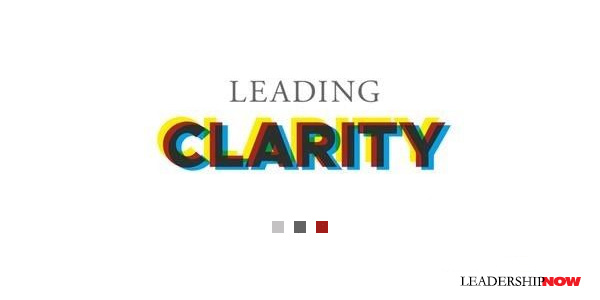
T In Leading Clarity, Brad Deutser states that “Clarity operates on the truth that everything is connected.” Clarity connects. “Clarity is the foundational fabric that weaves together dreams, goals, initiatives, concerns, challenges, and triumphs.” Clarity not only defines an organization, but it also protects and stabilizes it too. Considered as a destination, clarity can be lost or obscured the moment the landscape changes, or the environmental factors dim your view. In clarity, we can see all the factors, recognize them for what they are and what they can become, and create connections that can be relied on to establish or reestablish equilibrium and an environment for growth. This distinction matters to us because especially in times of great change and emerging opportunities, we can easily lose our way—our focus. Businesses fail—people fail—due to a lack of clarity. When disruptions come it is easy to move out of clarity. “Clarity become central to your ability to not only visualize, but actualize your performance.” Clarity should transcend your environment. When we are in clarity, we can maintain a constant flow of energy and maintain connections. Deutser identifies 12 circuit breakers that disconnect us from clarity: fear, ambivalence, clutter, labeling, doubt, impatience, boredom, conflict, overconfidence, physical depletion, inference or shallowness, and resources. This comment was interesting regarding our need to tolerate ambiguity: Being in clarity allows space where we wait for what we don’t quite understand to emerge, which keeps energy available and flowing rather than being boxed in, covered up, or mistakenly shelved through what’s already known. Too often we miss lessons, opportunities, and shifts in thinking, because we want to quickly fill the space of not knowing. Clarity needs structure and has to be created. So how do create this state of clarity? Deutser begins by working inside-the-box. We all work within constraints or within our particular box—a box of our own making. So we start by understanding our box. From there we can grow and/or change our box. When working in the box, your playing field is more defined and there is greater understanding of specifics and their possible impact on your desired outcome. There is also more empathy and connectivity in the box because there is definition. … The box provides a form of clarity for all to grab hold of and work toward. The powerful point is that the box is of your own making. You should also understand that while the sides of the box exist, they can be permeable, to let things flow in and out, and be flexible, to expand and contract when deemed necessary; but, once inside, each element serves to interact with the whole.
Direction: What are our values? Where are we headed? Is leadership aligned with values? Operations: Do we adapt well to change? What are our metrics? Do our systems and processes ensure high-quality work? People: Do we develop our team? Do we give timely and consistent feedback? Are we highly collaborative? Engagement: Coaching and Development, Talent Management, and Team Capabilities Organizational Identity: Who are we? Why do we exist? What motivates us? This side—your identity—is the foundations of everything you do. It is the foundation from which you can build the space for your thinking to exist in. Environmental Factors: What external factors affect or shape who we are? What do competitors do that we would never identify with or do ourselves? This framework helps you to understand who you are, where you are going, and how you work. As individuals and organizations we all have constraints. So it’s really what’s in the box that drives performance. Working within the box provides the context where innovation is likely and more importantly, implementable. When you understand the box it is easier to work and be productive within it. The box gives intentionality to everything you do. There’s no such thing as perfect, but “there is such a thing as being whole, which signifies the big picture as it weaves al the smaller pieces together. Being whole in this respect denotes a sense of closure that comes after all the parts fit together. Striving to be in clarity is about the process of becoming whole, of intentionally incorporating all the important aspects of your business into one connected form that accounts for the outside world as well.” It is the magic of your own ability to control [the construction of your box] that both protects and nourishes and becomes that which withstands and even thrives in chaos, change, and uncertainty. If you think of the sides of that box as being permeable rather than fixed, it frees the flow of input information in and the release of old ways and toxic byproducts out and away from your core. You build your own box. So what is your box and what do you need it to be? 
Posted by Michael McKinney at 06:41 AM
02.27.15

How to Grow Your Ability to Detect Change EarlyLeaders anticipate. It’s what they do. It’s the vision thing.But how do you increase your personal visionary capacity? How do we look ahead and anticipate the future and turn it into a compelling story that ignites our followers? Rob-Jan de Jong assures us in Anticipate that “We all can work consciously and continuously to grow our ability to anticipate, improve our game of looking ahead, have more remarkable insights, and become more inspirational in how we speak about the future.” He divides the process into four parts: Visionary Content (generating the ingredients that go into a powerful vision), Visionary Practices (developing the ability to see change early and connect the dots), Visionary Self (mindsets and attitudes that allow you to become more visionary), and finally Visionary Communication (the ability to verbalize and communicate your vision powerfully). A good vision must be rational but it also has to connect emotionally. Two key components of a vision that gets results are unconventionality and a connection to a noble cause. So often, where we get stuck is having a strong sensitivity to the world around us so that we can respond in an appropriate manner. Part two was useful in this regard. Seeing into the future is a function of noticing – open-mindedness, listening, playfulness – and then being able to connect the dots or understanding the implications of the changing realities you see. The author introduces a method he calls FuturePriming. It is increasing your awareness and picking up on seemingly hidden, peripheral signals. The way it works is to begin to create FutureFacts which are manifestations of a possible changing reality. 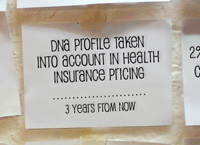 The process involves engaging your imagination to a current trend and creating a possible “headline” three to five years out. For example, based on current science a possible FutureFact or headline might be “DNA Profile Taken into Account in Health Insurance Pricing.” this kind of headline is a concrete, telling headline you will remember, and will start to serve you as a prompt when you hear or read about something that’s mildly similar. The process involves engaging your imagination to a current trend and creating a possible “headline” three to five years out. For example, based on current science a possible FutureFact or headline might be “DNA Profile Taken into Account in Health Insurance Pricing.” this kind of headline is a concrete, telling headline you will remember, and will start to serve you as a prompt when you hear or read about something that’s mildly similar.
You engage your imagination by entertaining unconventional, possibly disruptive, future events.FuturePriming is a very interesting approach to developing your awareness and to help you to become more sensitive to the seemingly random events you see happening in the world around you. 
Posted by Michael McKinney at 04:18 PM
02.19.15

6 Skills You Need to Win the Long Game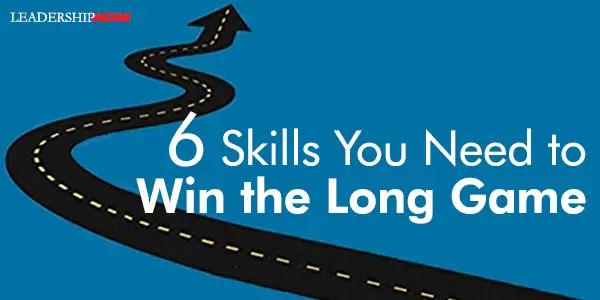
BRIAN DODD says he doesn’t like meetings but he loves strategy sessions because they are about movement and focus on accomplishment, not activity. They “make you glad you are a leader.” I presume he would agree with authors Steven Krupp and Paul Schoemaker. They say the number one business challenge for winning the long game is for leaders to become more strategic. In Winning the Long Game they write that “In times of crisis and change, when people are confused about what to do, ordinary leadership must rise to the level of strategic leadership.” The trick is to deliver short-term results while securing long-term viability. Especially in uncertain times, “companies must tilt more toward strategic leadership than toward operational excellence.” Strategic leaders need two perspectives: outside in and future back. Outside in means that a “strategic leader starts with the external marketplace when addressing problems, without getting wrapped up by internal organizational issues.” Future back means that when playing the long game strategic leaders use their long-term vision to guide their short-term decisions in a flexible way.
Anticipate: Strategic leaders are constantly vigilant, honing their ability to anticipate by scanning the environment for signals of change. They develop and maintain an external mindset. How quickly do you spot ambiguous threats and opportunities on the periphery of your business? (Chapter 1: Elon Musk) “Once a company becomes the master of its own universe, seeing new developments in adjacent markets becomes harder. Challenge: Strategic leaders question the status quo. Pope Francis is listening to new voices and deliberately bypassing old channels of communication. Open a window to let in fresh air and look in the mirror. Are you comfortable with conflicting views and differences in opinion? How often do you question your own and other people’s assumptions? (Chapter 2: Sir Richard Branson, Pope Francis) “Opening the window is the practice of promulgating outside perspectives to see complex issues in context. Looking in the mirror is the practice of deep self-reflection, whereby leaders confront outmoded beliefs, faulty assumptions, and stubbornness in themselves and others.” Interpret: Strategic leaders amplify signals and connect multiple data points in new and insightful ways to make sense of complex, ambiguous situations. Can you pick up on signals to distinguish anomalies from leading indicators of change? What are you not seeing or hearing? We begin by recognizing the facts and then “re-cognizing,” or rethinking, them to expose their hidden implications. (Chapter 3: Charles O. Holliday Jr.) “Leaders get blindsided not so much because they aren’t receiving signals but because they aren’t exploring alternative interpretations, or they get locked into one piece of the puzzle.” Decide: Strategic leaders seek multiple options to ensure flexible decision-making. They don’t get prematurely locked into simplistic yes/no choices. How often and how quickly must you make tough calls with incomplete information? (Chapter 4: Angela Merkel, Laurence Golborne) “Exploring options means having the wisdom, cool-headedness, and perspective to consider all of the alternatives available. Showing courage means demonstrating the fortitude to commit to the right solution and, if that solution proves ineffective, critically stepping back to reconsider.” Align: Strategic leaders engage stakeholders to understand change readiness, manage differences and create buy-in. They are adept at finding common ground. This requires active outreach. Good communication is key. Do you regularly engage your managers’ direct reports in decisions that affect their work? Where do you stand with the people you need to influence? (Chapter 5: Alex Ferguson) “There is an interconnectedness now in problems—and this changes the issues. You need to have more people involved with the decision making, leaving the leader less in control of the situation.” Learn: Strategic leaders continuously reflect on successes and failures to improve performance and decision-making. I like this chapter title: My Gift Was Not Knowing. It sums it up well. A quarter of a century after the publication of Peter Senge’s The Fifth Discipline, “the learning organization still does not have much of a foothold in the business world, despite skyrocketing uncertainty.” When was the last time you admitted you were wrong—in public? (Chapter 6: Reed Hastings, Sara Blakely) “Leaders must make their moves when the future is still ambiguous. If an organization is continually learning, then everyone is primed for change and ready to move in a different direction each day.” 
Posted by Michael McKinney at 11:27 PM
08.27.13

The Art and Science of Perfect Timing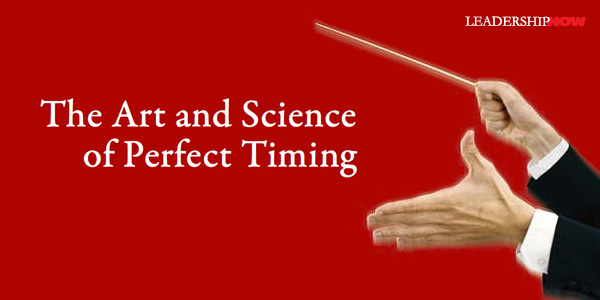
WE SAY timing is everything. And it is. But most of the time it just seems like good luck. In When, Stuart Albert says that using the right tools we can become better at managing and deciding issues of timing. Good timing is a skill that can be acquired. We miss timing issues “because the way we describe the world and the tasks we must accomplish omit the kinds of facts we need….They fail to include all the sequences, rates, shapes, punctuation marks, intervals, leads, lags, overlaps, and other time-related characteristics that are part of the temporal structure of everything that happens, every action that is taken, every plan that is implemented.” And we routinely omit them from our thinking. I had never thought of it that way. I was intrigued. If we don’t look for and note time-relevant characteristics like sequences, rates, duration, beginnings, and endings, we won’t have the information we need to make good timing decisions. For example, we question whether or not the incentives we have chosen are the right ones, but we don’t consider why those incentives became important at that particular time. Albert likens the structure of timing analysis to the structure of a musical score. There is a horizontal and a vertical dimension to it. Five horizontal—sequence, punctuation, interval, rate, and shape—and there is a vertical dimension—polyphony. The way they come together in an organization gives us insight into timing. These patterns form the temporal architecture. Sequence refers to the order of events, like the notes in a melody.
We have to learn how to listen for the rhythm of what is going on, for its moments of tension or release, for moments when we must pause and change direction. Learning to view events in this manner will help us to spot opportunities first, execute on them well, and avoid costly mistakes. The worst timing mistakes are not those that have significant human or financial costs, but those that appear to be inexplicable, where we ask, “How could someone have made a mistake like that?” One example of a sequence issue is Cooper Union’s decision to build a 166 million dollar engineering building on its campus in New York with the hope that a donor would step forward to fund the building. As of May 2013, nobody has. This is a classic sequence inversion error, playing notes out of order—in effect putting the cart before the horse. The first step should have been to attract the donor, who would help select the architect, and then become involved in the design of the building. In order to get the timing right Albert says we need to move beyond spheres and networks, boxes and arrows, trees and branches, and instead think in terms of a tall polyphonic musical score in which a large number of processes and events are playing at the same time. Here’s more:
When provides a more insightful way to look at events and the seven essential steps in a timing analysis. Timing issues are not always obvious but Albert helps us to know where to look and what to look for so we will be much more likely to get the timing right. 
Posted by Michael McKinney at 01:37 AM
06.19.12

Are You a Culturematic Maker?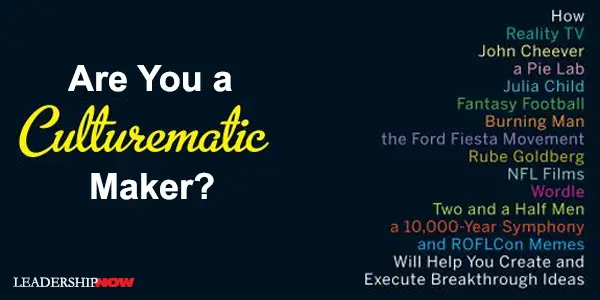
A Culturematic, says author and anthropologist, Grant McCracken, is a little machine for making culture. It is an exercise in edge finding. But at the same time, a Culturematic must speak to us. It must make us go, “Hmm, that’s interesting.” A Culturematic is also an attitude of mind that goes beyond the box of ordinary thinking “not because it is mischievous to do so, but because there might be a world out there and it might be interesting to find out what this world is.” McCracken says that because we live in a world of constant change and because we must adapt to it with an experimental stream of new ideas, we need Culturematics. It is when the problem is too complex or difficult and the solution is not forthcoming that Culturematics shine. Culturematics aren’t sure where they are going. When we aren’t sure what we’re looking at but think, “I’ll know it when I see it,” then we need ideas we can’t possibly guess we will need. “The trick,” says McCracken, “is to invent our own serendipity, to establish a cloud of possibilities in which we can spot the telling pattern.” Start a Culturematic by asking “what if?” Then, try it. The result should discover and distribute meaning. It helps us to see ourselves or something in the world, differently. It should also unleash value—even repurposing value; discovering “value in the artifact the maker does not know is there.” “Culturematics manage a tension between the order of the starting point and the unpredictability and disorder of the ending point.” This is not to say that we point a Culturematic in any direction and pull the trigger. A Culturematic is working with the culture that is already in place, so we point it in the direction where we think we might be able to create meaning and value. Culturematics... • start playing in our heads immediately. They capture our attention.
Fantasy Football, Twitter, and Reality TV are just a few of the examples of Culturematics discussed in the book. More can be found at the Culturematic Pinterest site. Culturematic is not based on entirely new ideas. However, it will not only make you look at the world (and what you are doing) differently, but you will develop a new appreciation for what you see, feel, and think. McCracken explains how to Culturematic yourself or your organization. Worth the read if you’re trying to create meaning and value in the world. 
Posted by Michael McKinney at 05:21 PM
03.02.12

Eisenhower, Kennedy & the Power of Vision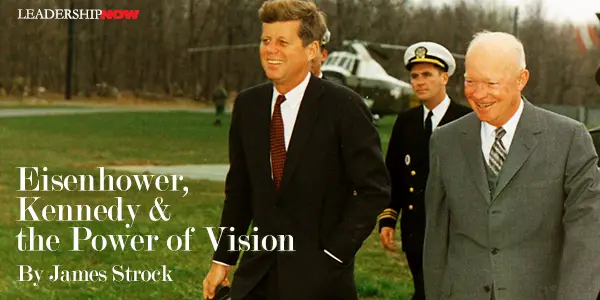
Serve to Lead, my book about 21st century leadership, includes respectful references to the management approach of Dwight Eisenhower. Some readers, I learned, had been unaware of the scope of Ike’s accomplishments. Some young people have scarcely heard of the thirty-fourth president. By contrast, many more people are aware of the leadership of John Kennedy, Ike’s successor. JFK is routinely ranked among the presidents most admired by Americans today. There may be lessons in the differing public understandings. Eisenhower Accomplishments Overlooked 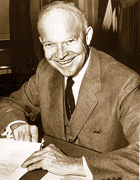 More recently, Ike has been rediscovered. In his new book, Eisenhower in War and Peace, respected historian Jean Edward Smith makes the case for Eisenhower’s exceptional leadership in war and politics. Ike: Civil Rights, Space The Eisenhower administration broke ground in the long-overdue struggle to accord African-American civil rights. Examples cited by Smith include:
So, too, he initiated the American space program, establishing the National Aeronautics and Space Administration in response to the Soviet Union’s successful Sputnik launch. And yet… how many Americans today recall Eisenhower’s decisive role in civil rights or the space program? JFK: Civil Rights, Space By contrast, John Kennedy is indelibly identified with each. It is impossible to know what Kennedy might have accomplished in the civil rights arena, had his life not been tragically truncated. As it was, his administration’s accomplishments were limited. In significant part this was because of his party’s reliance on the “Solid South,” and the conservative, rural coalition that held great sway in the Congress. JFK did convey public support at key moments. One was his celebrated telephone call of support to Mrs. Coretta Scott King, following the jailing of Dr. Martin Luther King, Jr. during the 1960 campaign. Most memorable was Kennedy’s June 11, 1963 speech on civil rights. He brought the American past, present, and future together, declaring: The heart of the question is whether all Americans are to be afforded equal rights and equal opportunities, whether we are going to treat our fellow Americans as we want to be treated. If an American, because his skin is dark, cannot eat lunch in a restaurant open to the public, if he cannot send his children to the best public school available, if he cannot vote for the public officials who will represent him, if, in short, he cannot enjoy the full and free life which all of us want, then who among us would be content to have the color of his skin changed and stand in his place? Who among us would then be content with the counsels of patience and delay? King was moved to dispatch a telegram in response, calling the speech “one of the most eloquent, profound and unequivocal pleas for justice and freedom of all men ever made by any president.” It is hard to imagine Eisenhower evoking such a response, despite the clear direction of his civil rights policies, and his personal expressions of commitment in various settings. So, too, JFK reframed the space race, urging the American nation to “commit itself to achieving the goal, before this decade is out, of landing a man on the moon and returning him safely to earth.” This extraordinary stretch goal was achieved, with the entire world witnessing it on television, on July 20, 1969. Though Eisenhower set the stage for the moon shot, it is difficult to imagine his casting such a vision, setting off such a mission. The Power of Vision Dwight Eisenhower was, fundamentally, a military man. In many ways, his presidency represented the best of the armed forces. Ike was publicly modest, chastened by the keen awareness of war and fateful decisions. He was down-to-earth, focused intently on results. His manner of communication was skilled yet unpretentious. He was not eloquent per se, other than in the sense that his presence lent eloquence to his statements and sentiments. 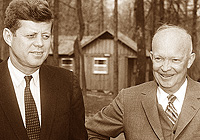 John Kennedy was a man of history and words. He was a skilled writer. He undertook to make himself a great speaker. Where Eisenhower sought to inform, Kennedy sought to inspire. His ennobling vision, evidenced in the civil rights and space examples, created its own power. He would lead first, with management harnessed to serve its ends. Had Kennedy fully appreciated Eisenhower’s deft management of large enterprises, he might well have avoided early missteps, such as the Bay of Pigs invasion. Had Eisenhower had Kennedy’s skill with vision and communication, he might well be remembered more passionately, his achievements more clearly recognized. From a distance, one might say that Eisenhower’s and Kennedy’s strengths as leaders were paired with their weak spots. Perhaps. Yet that need not stop up from striving to learn from both of their examples at their best, just they studied and learned from others. 
Posted by Michael McKinney at 02:35 PM
12.14.11

Avoid Trivia
CAUGHT UP IN our day-to-day struggles, keeping our eye on the big picture is difficult. We can become distracted by the relatively trivial matters to our larger purpose. To be sure, the daily minutia needs to be dealt with, but the trivia will always be there to deal with, to distract us, to take us off-course, to cause us to doubt and give up. What is important is what you pay attention to. Where you place your attention will determine the course of your life.  Kennan recalls that he offered no observations or suggestion of his own. When he asked for advice, Kennan writes, “The only advice he had to give me was expressed in two deeply serious and unforgettable words: avoid trivia.” Kennan says when they began they encountered a great deal of skepticism and pessimism. “To every idea we put forward, weighty and often plausible objections were raised. The problem we were told was too great: the resources were not there; the Europeans would never consent to take the initiative; whatever help we might be able to offer would merely sink into the sands.” But their instructions from Marshall were to not listen to those voices—avoid trivia. Those voices are always there in any worthwhile effort we make. The tension between the trivial and the weighty matters is a part of life. Avoid trivia. Stay focused on the weighty matters. Choose the things that capture your attention—be intentional. Avoid the worthless things.
Posted by Michael McKinney at 08:31 PM
06.27.11

The Big Vision is Important but People Live in the DetailsMost leaders don’t want to be called a tyrant, a control freak, or even a micromanager. To avoid that, it’s easy to jump into the other ditch and be laissez-faire. Leaders have a duty to navigate between these two extremes as the situation dictates.Typically, we like to present the vision—the values—and leave the details to be sorted out. We like to give the big overarching principle without explaining exactly how it plays out in everyday life. The problem is that everything happens in the details. That’s where people live. That’s where decisions are made, community is built, and your vision and values are realized—or not. We like to articulate the “promised land” and expect that everyone will catch on. That might work for the most highly visible leaders—those interacting with employees day-in and day-out—because they see you translating those values and goals on a day-to-day basis. But seriously, how many of us are that visible? We’re far too busy!?! We don’t want to be caught telling people what to do, but we want everyone on the same page. Life doesn’t work like that. People see the same thing and hear the same thing differently. They interpret it differently and thus it plays out in their behavior differently. And that is where the friction starts. That’s where the community breaks down. That’s where the judgment begins. Organizations, groups and families need more guidance than that. I’m not suggesting that we become control freaks, create even more rules, or become condescending or judgmental, but we need to clarify the vision and values in the details where people live. What do our values look like in everyday life? We need to use examples as they come up to relate everyday behavior to our values. Show where they match-up and where they don’t in a way that leaves room for them to develop good judgment and practical wisdom. From the beginning—and along the way as needed—we need to spell out, “This is the kind of company we want to be, this is the kind of people we want to be, so that means we don’t do this but we do do that.” Specifically. And we then communicate this over and over again in our rhetoric and actions. People need to know and understand your values if their behavior is to be guided by them. If there is a disconnect between your values and everyone’s clear understanding of them, confusion and misbehavior will define your leadership.
Posted by Michael McKinney at 08:17 AM
06.23.11

The Essential Ingredient for Executing Your VisionIf you don’t build a framework of values around your vision, it will fall short of the goal. And those values must be clearly understood by everyone on the team if the initiative is to succeed, for a couple of basic reasons.A vision is what could be, but it is grounded and guided by—or even sent off-course by—your most deeply held values—what is. A vision is generated from and is sustained by values. A vision is generated by values because what we see comes from what we are. The values we hold to, how we interpret where our values have taken us to this point, and the values we discard, inform our vision. Our values give us a line of sight into our future. To have a vision bigger than we are, we need to incorporate values into our thinking that are bigger than we are; values that come from outside ourselves. Values then become the instruction book. They show the way, directing our decisions and behavior. Inasmuch as our vision arises from our values, so too our values support and sustain the vision. The connection between value and vision points to the need to have a firm grasp of our values before we create our vision, because they’ll either point us in a positive direction or send us to a destination full of regret.
Posted by Michael McKinney at 08:45 PM
05.24.11

Got Drama?
YOU can’t stop The Drama. There will always be drama. But that’s not the problem says Marlene Chism, author of Stop Workplace Drama. “The amount of time you stay in the drama—and the effort you put toward it—is the problem. Complaints, excuses, and regrets only serve to keep the drama alive.” Your drama—what you add to The Drama—is the problem.Chism defines drama as “any obstacle to your peace and prosperity.” Drama is the result of not recognizing or taking care of the little signs of bigger problems when they first presented themselves. At the core of drama, you will find one of three common elements (if not all three): a lack of clarity, a relationship issue, and/or resistance. So, says Chism, when you experience drama you need to ask yourself three questions: 1. Where am I unclear?
Chism presents eight principles for dealing with drama, but “lack of clarity” struck me as the most common and excuse-laden trap there is. Too often this is where we get stuck.
“Any type of discord, abuse, confusion, or game-playing always boils down to a lack of clarity.” A loss of focus. Sometimes we create drama because we want something on our terms. We imagine that we can’t do something because we can’t do it the way we think it should be done—our way. Chism relates a clarifying example of this with the recently divorced Joe who is having visitation issues with his ex-wife Patty. She’s not letting him do what he wants in the way that he wants. Many people get stuck in the drama of what should or shouldn’t be. Yes, you can fight that battle, if winning a battle is what you want. But again, in order to clear the fog and help Joe get clarity, I asked, “If there are two islands you can go to, and one means winning a battle with your wife and the other island is getting to see your kids and be a father to them—then which island would you choose?” This kind of dynamic plays out every day in our business and personal lives. When we are not clear about what we want, what our values are, what we are committed to, it is easy to lose our focus, to drift off course Solution: Clear the fog. Chism has written a good-natured and practical book that will change your thinking and in the process help you to control the drama in both your personal and professional life. As leaders, we have the responsibility to be very clear with ourselves and our team so that we don’t get pulled into negativity, gossip, power plays, resistance and … drama. Chism suggests asking the following questions: What are my top 10 principle-based values?

Posted by Michael McKinney at 10:00 PM
03.18.11

5 Leadership Lessons: The Velocity Manifesto In today’s high-velocity environment, Scott Klososky believes you need to understand how to guide your organization in the implementation and usage of technology—in short, how your organization “does” technology. [As a leader], you—not the IT department, nor the VP of IT, nor the chief information officer (CIO)—must understand, drive and be accountable for how technology is structured in order to reach the strategic goals of the operation….Technology enables velocity—the speed of getting products to market, the speed of delivery, the speed of analytics, and the list goes on. Speed is our friend in almost every case. An organization’s digital plumbing is what facilitates this speed, and it has become the single most important variable for success in many organizations.The Velocity Manifesto 
Posted by Michael McKinney at 04:54 PM
03.15.11

How Did They Get Ten Steps Ahead of the Rest of Us?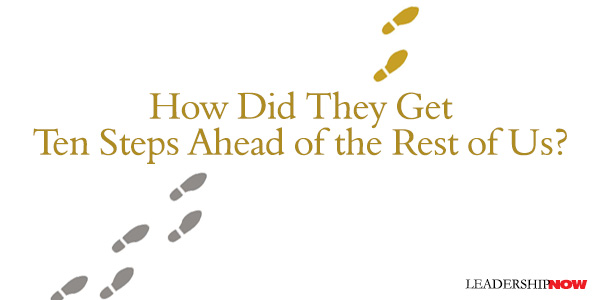
ERIK CALONIUS wants to know what makes a visionary? What allows a Steve Jobs, Walt Disney, Berry Gordy, John Lennon, Richard Branson, and others like them, to do what they do? How do they see what the rest of us are missing? Blending cognitive psychology, neuroscience and (mostly) first-hand accounts of the visionary’s life, in Ten Steps Ahead, he builds a picture of what makes them tick. He identifies the importance of intuition and emotional intelligence and the role of courage and conviction in separating visionaries from mere dreamers.“Visionaries don’t succeed by lying in bed with their dreams floating idly by above their heads. They get out into the world and experience things, and from that, shape their ideas.” It’s being a first-class noticer as Warren Bennis suggested. Calonius cites Thomas Kuhn’s work on paradigm shifts and the years of “mopping up” that follow them. Julian Huxley wrote in 1957, “Once science has reached the stage of having a coherent theoretical basis, it will inevitably proceed … to make further discoveries and further extension of its theory.” Calonius explains: That’s why commercial products often follow scientific breakthroughs by about 20 years or so. … “First movers,” in other words (and contrary to the mantra of the “New Economy” of the late 1990s), very often do not prevail. This means you don’t need to deliver the paradigm to mop up quite successfully in its aftermath. You don’t even need to be the first mover. Just be clever enough to make off with the flotsam of the paradigm after it has crashed upon the shore. The reoccurring insight I find in these pages is that it really comes down to the ability (and confidence) to walk a fine line, to develop a balance of thought. For example, pattern recognition allows visionaries to make connections and see what is not yet seen. Yet at the same time, pattern recognition can lock us into a constrained view of life of our own making. “The same patterns that help us predict the future are also the ones that lock us into the present.” Calonius observes, “Intuition is essential to the visionary. Visionaries almost always work at the edge of our understanding, where information is scarce or nonexistent and where intuitive decisions are often the only choice.” But again, there’s a balance. If we follow our intuition blindly, we can lose it all. “Intuition is a judgment call” that must be developed. “Practiced insight, leavened with intuition.” Emotional intelligence is also an important element. It is “that rare balance between dry logic and emotional intuition.” It gives the visionary the ability to read others, and thereby be able to rally others behind their idea. Of course, luck plays a part. In The Drunkard’s Walk, Leonard Mlodinow writes, “Keep marching forward because the best news is that since chance does play a role, one important factor in success is under our control: the number of at-bats, the number of chances taken, the number of opportunities seized.” One of the greatest challenges to visionaries—indeed all of us—says Calonius, is “to get outside the walls, to rise over the yes-men and sycophants and even their confidence in their own ideas, to be able to see clearly.” Visionaries are all around us. The brain is remarkable in that it is an ever-changing network of circuitry that learns as we live our lives. We can guide that process to, as Joseph LeDoux says, “transcend our genes.” We can be visionaries too. Visionaries keep “running forward, adjusting their ambition along the way.” 
Posted by Michael McKinney at 10:08 PM
10.29.10

It’s a Jungle in There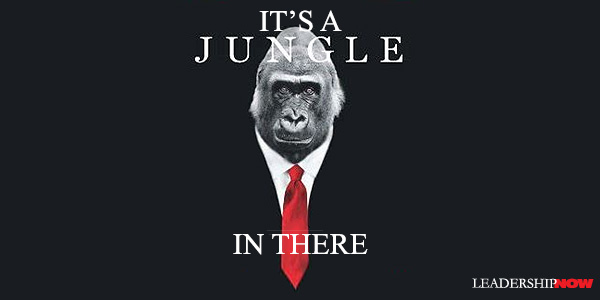
ANYONE that has ever been to the Rainforest Café, knows it's a treat. Created by Steven Schussler, the Rainforest Café holds the record as one of the top-grossing restaurant chains in the world and was the first restaurant concept to be featured at every Disney theme park worldwide. Schussler shares in It’s a Jungle in There, what it takes to make it happen and the lessons he learned that can be applied to your dream. Schussler embodies the five Ps of successful entrepreneurship—Personality, Product, Persistence, People, and Philanthropy—that he teaches in the book. He writes, “As a leadership quality, one’s own passion is what galvanizes others into action.” Passion and persistence has played a big part in everything Schussler has done. It’s “not going through the motions but going through with the emotions.”
“In the bedroom, my bed was constructed to look like it was suspended in a tree….Birds and animals moved freely through the area during showings of the house….Every room, every closet, every hallway of my house was a ‘scene’: an attempt to present my idea of what a rainforest restaurant would look like in actual operation….No venture capitalists were going to invest their money in my far-out concept without actually seeing it, so I transformed my house into my vision of what a rainforest restaurant would look like in order to make them believe in my dream.” Naturally, this would catch the attention of your neighbors (and law enforcement) too. There were problems of all sorts as you can imagine. And Schussler writes, “Being passionate doesn’t totally shield you from moments of doubt.” But his passion finally won out. How far are you willing to go to see your dream realized? In short, high-content chapters, he explains his guiding philosophy and backs them with concrete experiences. He has two quotes framed on the wall over his desk: “When you’re out of quality, you’re out of business” and “The noblest search is the search for excellence.” He talks about looking for “enhancement gaps.” Those gaps between “what you are seeing and what you could create to make what you are seeing better by providing some product or service.” He asks, “Are you willing to help other people succeed even when it’s not a requirement of your job to be of assistance?” Self-control: “What you don’t want to do is say things and/or act in a manner that will create negative impressions and the unwanted consequences that are certain to follow.” You must know your audience. Burning Bridges/Writing People Off: Don’t do it. “What I learned that day reconfirmed my belief that ego can be a killer, especially an unchecked ego. Most entrepreneurs need to have a healthy ego, but you also have to be realistic. That’s a very delicate balance—the kind of balance you need to cross a bridge you tumbled off the first time around.” Anyone would benefit by reading and integrating the lessons offered here. 
Posted by Michael McKinney at 03:13 PM
09.06.10

Getting Ideas to Flow
Charles Landry is the founder of Comedia, and works to help cities to be more "creative for the world" so that the energies of individuals and companies can be brought into alignment with their global responsibilities. He recently told Sally Helgesen that his experience has taught him that “the single biggest problem in the world is not finding great ideas but getting great ideas to move, to flow.” Getting stuck is an issue we face both individually and organizationally. At its core, it’s a thinking problem and is often self-inflicted. Creating the right kind of movement and in the right direction begins with re-thinking our view of reality. If we keep applying the same patterns of thinking even after they have been shown to be counterproductive we skew our perception of even everyday life situations and block the flow of growth, ideas, and influence. Here are some common areas we need to rethink to get ideas to flow: Re-think complexity. We create complexity by over-analyzing our situation; creating issues where there are none; forgetting our purpose. Complexity obscures the issues. Keep the issues as uncluttered as possible. Often an outsider can see the situation and the real issues more clearly than you can. Try asking, “Am I making this a bigger problem than it is because of fear, insecurity or lack of knowledge?” “Is this really a problem to be solved or a tension to be managed?” Stick to what needs to be addressed. Complexity can lead to procrastination. Re-think systems. Trying to create a new vision without addressing old systems is at best counterproductive. Tenaciously grasping the old ways of doing things just because that is what you have always done, can stop the flow of ideas and innovative solutions and lead to hopelessness. If you are experiencing a chronic lack of movement, a resistance to change or lack of compliance to your “really good idea,” you probably have a system in place that discourages the very behavior you seek. A system should reward the behavior you want. What systems are getting in your way? Re-think ego. Our ego frequently keeps us from exploring new ideas. We get so invested in what we have done that we can’t get out of our own way. We keep retrying to work the old and deceive ourselves into thinking we’re making progress when all we are doing is rearranging the deck chairs on a sinking ship. Sometimes we need to set aside our ego and simply abandon what isn’t working and start over with a better design. Re-think boundaries. Think bigger. Think interdisciplinary. Growth often involves blurring boundaries to open your mind to new possibilities. What principles outside of your world of experience could expand the possibilities for your idea? Re-think reactions. Repetitive reactions are the result of ingrained patterns of thinking that we have hard-wired into our brains long ago. Take the time to reflect on why you think the way you do; why you do what you do. Default patterns of thinking lead to more of the same. Ask yourself, “Is this working for me?” Think about the unspoken. Re-think failure. If you’re afraid of being wrong, embarrassed by failure or paralyzed by insecurity, you will never find the solutions that lead to meaningful growth. Failure provides the nutrients for growth when we respond to them positively. Keep failure in perspective, it’s a regular part of life. You can’t avoid them so learn to work with them. Failures help you to raise the bar and reorient your thinking to possibilities and new ways of thinking. Re-think success. Know what success looks like. How will you know when you have arrived? Muddy expectations lead to exhaustion and defeat before you even get started. Praise short-term accomplishments to appeal to your heart and not just your head. It will keep your ideas moving along. 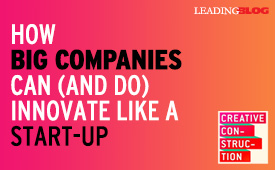 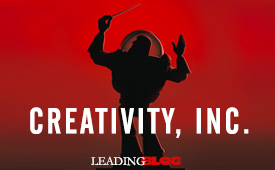
Posted by Michael McKinney at 03:16 PM
08.23.10

There’s No Such Thing As Mature Companies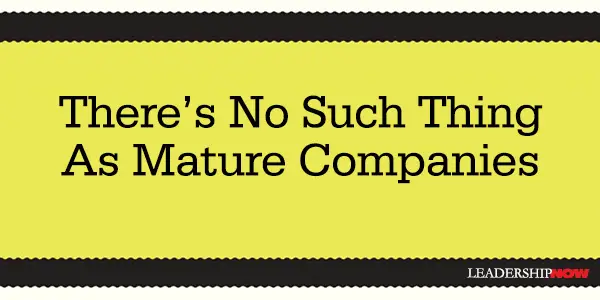
WE have all been told that businesses have a life cycle. It’s usually broken down into start-up, growth, maturity, and decline. But in terms of agility and sustainability, that’s not a helpful way to look at it. If you intend to lead people for the long-term, you need to consider a different outlook. London Business School professor Don Sull says that the secret to the fountain of youth is: “companies do not pass through life cycles, opportunities do. Most firms, particularly large organizations, oversee a diverse portfolio of opportunities that exist at different stages of the life cycle.” Even one-hit-wonders can find hidden opportunities if they look hard enough. To view what you are doing through the lens of the business life cycle, tends to make you myopic and limits your thinking. A perspective that emphasizes the opportunity life cycle encourages agility and openness in your thinking. Sull writes in The Upside of Turbulence, “There are no mature companies, only portfolios overloaded with mature opportunities. Organizations can avoid a corporate midlife crisis through portfolio agility—the ability to quickly and effectively shift resources, including cash, talent, and managerial attention, out of less promising units and into more attractive ones.” “To achieve portfolio agility,” writes Sull, “leaders should view their organization as an array of opportunities at various stages in the life cycle, paying attention to promising opportunities. The trick, then, is to keep your opportunities in balance. With that in mind, the following questions are helpful:
While this is directed at organizations, how might you apply this to your own personal life path? How might you keep your personal portfolio in balance and relevant to your world? 
Posted by Michael McKinney at 07:49 PM
08.06.10

Do Your Goals Look Like a Variation of What You’ve Always Done? WE’VE all heard about SMART goals. The idea has been around for about 30 years. SMART goals are Specific, Measureable, Achievable, Realistic, and Timebound. Sounds reasonable. But Mark Murphy thinks they often “act as impediments to, not enablers of, bold action and actually encourage mediocre and poor performance.”
WE’VE all heard about SMART goals. The idea has been around for about 30 years. SMART goals are Specific, Measureable, Achievable, Realistic, and Timebound. Sounds reasonable. But Mark Murphy thinks they often “act as impediments to, not enablers of, bold action and actually encourage mediocre and poor performance.”
SMART goals seem to say, he contends, “Don’t push beyond our resources; don’t bite off more than you can chew; play it safe and stay within your limitations.” Maybe if we weren’t so focused on making sure our SMART goals were written correctly on our goal-setting forms, we might ask, “Is this goal fundamentally wimpy?” “Most organizations are pretty good at filling out forms correctly” says Murphy. “What we’re less adept at is making sure the content on those forms is gutsy and challenging enough to result in something great.” Perhaps our SMART goals are beginning to look like more of the same. There is the ever-present pull to keep doing things the way we have been doing them. There’s a feeling of safety there. We like to stick to what’s known. The result is that our goals can look like a variation of what we’ve always done. To be outstanding, to rise above the noise, we need challenging, we need inspiring, we need essential. To overcome inertia, Murphy recommends we set HARD goals. In Hundred Percenters he describes HARD goals as: Heartfelt, Animated, Required and Difficult. “Every business plan we write represents an opportunity. Every sales presentation, every customer interaction, every budget request, and every financial approval is a chance for us to push ourselves and our employees toward untold greatness.” HARD goals are: Heartfelt. Working for something bigger than oneself. “If you want to build a heartfelt higher purpose into your goals … make your goals NOBLE.” (Name a party Other than ourselves who will Benefit from this goal Like customers or End users.) Animated. One critical reason people don’t get excited about their goals is that “our goals typically sound sterile. When’s the last time you got so jazzed about the thought of hitting your budget target that you actually fantasized about the exact moment you would present the results to the team.” Help people to experience your goal. Imagine if Martin Luther King, Jr. had stood on the steps of the Lincoln Memorial and said, “Our goal should be that within the next 30 years, the incidents of hate crimes will be reduced by 63% and that the percentage of minorities living below the poverty line will be no higher than the percentage for any other racial group.” Those would be aspirational goals, to be sure. But inspirational? Not so much. Required. HARD goals do “more than paint a picture of something in the future. It also solves deep-seated pain. HARD goals aren’t just nice to do, they’re necessary to do.” If you’re going to set a HARD goal, you need to let people know why it is required. Difficult. It is possible to set a goal that is so difficult that it is demotivating, but that is rarely the issue. How difficult is difficult? Murphy asks two questions: What new skills (if any) will you have to learn to achieve these goals? And Do you think you can accomplish these goals? “If they aren’t learning all sorts of new skills, then your goals are probably not heard enough.…Hard goals are scary and force us to question our abilities. So if your employees knew they could accomplish the goals before they even started, try making [them harder].” When you announce your HARD goals, you’re going to see visible signs of perspiration and palpitations as folks listen…. Your employees 
Posted by Michael McKinney at 08:14 AM
12.11.09

Is Your Story Winning Hearts and Minds?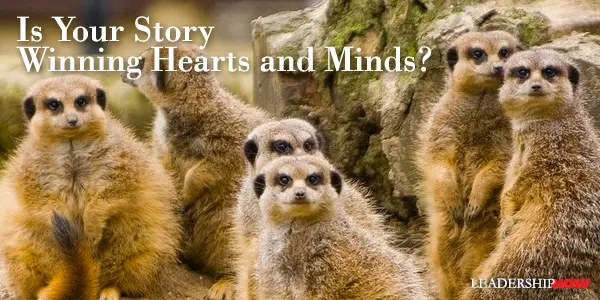
LEADERSHIP is part of a story. Leaders answer the why; they tell the story. Leadership is paradoxical because while leaders must manage the realities, they lead in the ideal. In The Visionary’s Handbook, Watts Wacker and Jim Taylor advise leaders to have the right story—a simple, consistent story that connects the past, present and future. But it needs something more: It should have some melodrama; some action; climax and resolution; a plot that turns toward the good at the end on the strength of a key virtue; a beginning, middle, and end—all the things that were taught in Literature 101 because in the last analysis a great story must be just that: a great story. Negative capability is an interesting concept. It was coined by John Keats in a letter to his brothers (George and Tom), dated December 21, 1817. He wrote: I had not a dispute but a disquisition, with Dilke on various subjects; several things dovetailed in my mind, and at once it struck me what quality went to form a Man of Achievement, especially in Literature, and which Shakespeare possessed so enormously - I mean Negative Capability, that is, when a man is capable of being in uncertainties, mysteries, doubts, without any irritable reaching after fact and reason-Coleridge, for instance, would let go by a fine isolated verisimilitude caught from the Penetralium of mystery, from being incapable of remaining content with half-knowledge. Keats thought, that one of the qualities of great people is their ability to sublimate their own individual assumptions and persona—that is, to make themselves a negative—and thereby contemplate the world without the desire to try and reconcile contradictory aspects or fit it into closed and rational systems. This requires being a good listener and the ability to say, “I don’t know.” 
Posted by Michael McKinney at 03:13 PM
10.22.09

Save the World and Still Be Home For DinnerSave the World and Still Be Home For Dinner by Will Marré shows how can we can both live life on our terms and do something that matters for others, how we can both find financial security and live life as a personal adventure, how we can both make radical changes in life and keep the relationships and things we most value. "After all," Marre says, "Isn't that what we all want? To save the world and still be home for dinner?"In a thought provoking interview, Will Marré speaks to Vision about about leadership, organizations, changes in the corporate world, personal contentment, and quality relationships. “The critical issue of leadership today is moral intent. If we get people who are very effective at being leaders, who don’t have worthwhile moral intent, we get what we got.” “Self interest is not a sufficient motive to create valued innovation. In other words, big innovation.” Many large organizations, “become protected around their financial well-being and they start to look at everything in terms of financial risk and so it thwarts true innovation.” “It all comes down to the quality of intimacy in our relationships. In other words, there’s no success that compensates for a lack of that high quality intimate relationship with at least one other if not several other human beings. We don’t get that without making an effort. We don’t get that by being stupid about relationships.” “If you imagine the very best thing you can do … and what might be really good is being the best mother you can be this afternoon or the best father you can be tonight. Sometimes the best way to change the world is to change a diaper. In other words, there are moments of truth everyday – many times – and if we step in do the best thing we can imagine doing in those moments of truth, then we will set up a chain of life that is self-reinforcing, self-motivating, self-fulfilling.”
Posted by Michael McKinney at 11:24 AM
06.17.09

Iconoclast: Learning to Think DifferentlyCREATIVITY and imagination is in the space between revolutions and everyday life. They fuel change and, most of the time, progress. Bringing new thinking to old patterns is the job of the leader. In a sense, leaders are to varying degrees, called to be iconoclasts. Neuroscientist Gregory Berns says that not only is an iconoclast a person who does something that others say can’t be done but their mind functions differently than the average mind. Those functions are perception, fear response and social intelligence. Because the mind is designed to function as efficiently as possible, it serves as its own barrier to being an iconoclast. (The brain runs on about 40 watts of power. There is partial truth to the myth that you only use 10-15% of your brain. We use all of our brain, but only a fraction of the brain is active at any given time to conserve energy.) In Iconoclast, Berns explains that “when confronted with information streaming from the eyes, the brain will interpret this information in the quickest and most efficient way possible.” This “efficiency trap” blocks us from seeing alternatives to what we perceive as real; it imposes limitations to what we believe is the only way of seeing something. Iconoclasts don’t allow themselves to fall into the efficiency trap as often as the average person does. “Automatic thinking destroys the creative process.” Berns adds—and the implication is very important—“iconoclasts, either because they were born that way or because they learned how to do it, have found ways to work around the perceptual shortcuts that plague most people.” Thus, we can learn to do this too. Fundamentally, we need to create novel experiences. Iconoclasm begins with perception….Sometimes a simple change of environment is enough to jog the perceptual system out of familiar categories….Unfamiliarity forces the brain to discard its usual categories of perception and create new ones….When confronted with places never seen before, the brain must create new categories. It is in this process that the brain jumbles around old ideas with new images to create new syntheses. The iconoclast’s fear response—specifically the fear of uncertainty and the fear of public ridicule—are different than that of the average person. Fear is damaging to creativity in the workplace. “In many people, the brain would rather avoid activating the fear system and just change perception to conform with the social norm.” You can not eradicate the fear response but you can learn to tame it. “Neuroscience is showing how the rational part of the brain can regain control over such toxic emotions like fear.” The individual who feels overwhelmed by uncertainty or social stresses in the workplace may benefit from taking on projects that have defined endings. Although these may increase in the short term, their completion may actually decrease overall stress. All of this is well and good, but to be a successful iconoclast, you must be able to sell your ideas to other people. That boils down to social intelligence. “As well-respected, upstanding citizens, connectors form the glue of local society. Iconoclasts, by their very nature, upset this delicate web of connectedness. But iconoclasts need connectors. Without them, the iconoclast stands no chance of achieving success. Sometimes iconoclasts have to create the connectors themselves.” Additionally, it is a challenge to leaders to be able to find ways to connect iconoclasts to others so that their talents and insights can be capitalized on organizationally. It is extremely rare for one person to have all three qualities of a successful iconoclast. But you can compensate by building a team around you in areas where you aren’t strong. Iconoclast: A Neuroscientist Reveals How to Think Differently is supported by research and persuasive stories. The immediacy of the topic will be helpful not only to individual development but to organizations seeking to bring new thinking to old patterns of thought. 
Posted by Michael McKinney at 12:42 PM
03.18.09

Collapse of Distinction: How Do You Get People Thinking About You?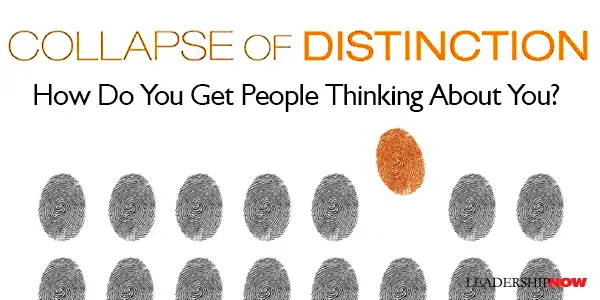
I'VE SEEN Scott McKain speak on a couple of occasions and he is all about customer experience in both content and delivery. His new book Collapse of Distinction, is no different. The collapse of distinction is a cultural phenomenon of not just blandness, but sameness. McKain writes that it has become a “corporate and professional nightmare.” The current economic environment makes this book all the more important. The problem isn’t just the economy though; it’s that the economy exposes a problem that is more easily ignored in a good economy. To ignore the collapse of distinction now, can be fatal. Today customers want value more than ever. How will you create that value? Low price isn’t the answer, but without doing the homework, that’s really all you’re left with. McKain writes, “If you cannot find it within yourself to become emotional, committed, engaged, and yes, fervent about differentiation, then you had better be prepared to take your place among that vast throng of the mediocre who are judged by their customers solely on the basis of price. It is the singularly worst place to be in all of business. If you aren't willing to create distinction for yourself in your profession—and for your organization in the marketplace—then prepare to take your seat in the back, with the substantial swarm of the similar, where tedium reigns supreme.” Three factors conspire to destroy differentiation:
Coming to grips with this propensity of human behavior takes a lot of effort. We would rather “execute the least progressive, most conforming activity [we] can to achieve the success [we] desire.” However, McKain lays out the process to overcome sameness to lift you or your company out of the doldrums, as clearly and as simply as possible. How do you grab attention? How do you get people thinking about you? How do you get the opportunity to use the combination of your expertise and talent? You can differentiate yourself on product, price, and/or service. For most of us, the only real way we are going to differentiate ourselves is through service. McKain lays out the Four Cornerstones of Distinction and devotes a chapter to each explaining how you apply them in your situation: Clarity, Creativity, Communication and Customer-Focus. Each chapter ends with an executive summary and solid action-points to get the ball rolling. He says that we have to profitably create experiences that are so compelling to our customers that loyalty is assured. Your organization's survival may depend on the concepts presented in this book. “What is compelling about you, what will create points of distinction about you, and what will establish a connection between us?” You do not need to change everything about how you do business to create distinction. Start by walking through your list of points of contact with customers, reframing and redefining how you perceive each moment of interaction. From these new perspectives, you can then begin to create specific points of differentiation with your customers. By developing your professional laundry list from the exercise—and recognizing that if these practices are the industry standard, then they will almost always fail to create distinction for you—you are taking an important first step in disciplining yourself as a professional to develop differentiated methods and tactics. Different is not just good, different is better. UPDATE: Collapse of Distinction has been updated and retitled: Create Distinction: What to Do When ''Great'' Isn't Good Enough to Grow Your Business (2013) 
Posted by Michael McKinney at 03:56 PM
02.19.07

Henry Kissinger on Vision: Seeing Through a Glass Darkly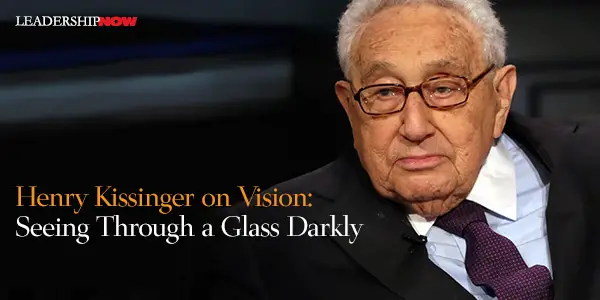
HENRY KISSINGER, then U.S. Secretary of State, explained in an interview with Los Angeles Times concerning the risky restoration of U.S. diplomatic relations with China, the dynamics of vision. “What a national leader has to do at such a time, is to take his society and the world, insofar as the issues are international, from where it is to where it has never been. This means he cannot prove the destination is desirable until the society or the world gets there.” Nixon himself once told professor Joan Hoff in an interview that the mark of a leader “is whether he can give history a nudge.” Nixon recognized that a leader should be inclusive. He wrote in a 1967 Foreign Affairs article, “Taking the long view, we simply cannot afford to leave China forever outside the family of nations, there to nurture its fantasies, cherish its hates and threaten its neighbors.”
Posted by Michael McKinney at 05:44 AM
04.28.06

You Have a Business and People Don’t Get It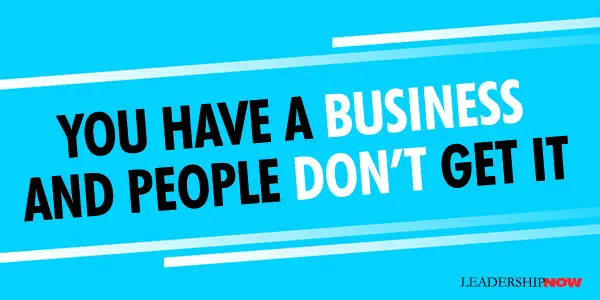
IN a survey conducted by Dan Topf of Management Development International, respondents—a mix of line employees and executives—were asked ten simple questions, such as “What percentage of each dollar the company takes in as sales does it keep as profit?” and “Would customers pay for what you accomplished last week?” The point was to not only get at what the respondents understood about business, but also what they understood about how they contributed to that business. Training contributing editor Holly Dolezalek reported on the results: The results were mixed, and Topf says that’s exactly the point. All kinds of employees, both higher- and lower-level employees, had answers all over the map for these questions. Some had wildly inaccurate ideas about how much of a company’s sales turn into profits. Others knew what their company’s profit margin was, but had no idea how it was reached; and many said that they believed their company’s strategy would be successful, but that they had no impact on that strategy or on the company’s cash flow. How are we doing at communicating what it is we do and how we determine how well we are doing it? The macro view. When people know where they fit in and what their unique contribution is, they can then move beyond mere employees and become leaders. They can lead from wherever they are in the organization and that will contribute to the bottom line.
Posted by Michael McKinney at 01:16 AM
|
BUILD YOUR KNOWLEDGE
 

How to Do Your Start-Up Right STRAIGHT TALK FOR START-UPS 
Grow Your Leadership Skills NEW AND UPCOMING LEADERSHIP BOOKS 
Leadership Minute BITE-SIZE CONCEPTS YOU CAN CHEW ON 
Classic Leadership Books BOOKS TO READ BEFORE YOU LEAD |
|